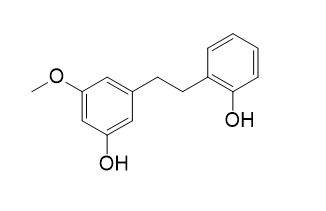Batatasin IV
Batatasin IV is an LTA4H inhibitor with anti-inflammatory activity. Batatasin IV can be used in research in the area of inflammation.
IC50 & Target:LTA4H
Inquire / Order:
manager@chemfaces.com
Technical Inquiries:
service@chemfaces.com
Tel:
+86-27-84237783
Fax:
+86-27-84254680
Address:
1 Building, No. 83, CheCheng Rd., Wuhan Economic and Technological Development Zone, Wuhan, Hubei 430056, PRC
Providing storage is as stated on the product vial and the vial is kept tightly sealed, the product can be stored for up to
24 months(2-8C).
Wherever possible, you should prepare and use solutions on the same day. However, if you need to make up stock solutions in advance, we recommend that you store the solution as aliquots in tightly sealed vials at -20C. Generally, these will be useable for up to two weeks. Before use, and prior to opening the vial we recommend that you allow your product to equilibrate to room temperature for at least 1 hour.
Need more advice on solubility, usage and handling? Please email to: service@chemfaces.com
The packaging of the product may have turned upside down during transportation, resulting in the natural compounds adhering to the neck or cap of the vial. take the vial out of its packaging and gently shake to let the compounds fall to the bottom of the vial. for liquid products, centrifuge at 200-500 RPM to gather the liquid at the bottom of the vial. try to avoid loss or contamination during handling.
Chem Biol Interact.2023, 378:110487.
Phytomedicine.2019, 58:152893
Int J Med Sci.2024, 21(15):2883-2896
J Ethnopharmacol.2020, 249:112396
The Pharmaceutical Society of Japan2018, 138(4):571-579
Environ Toxicol Pharmacol.2019, 66:109-115
Korean Journal of Pharmacognosy.2015, 46(4):352-364
Pharmacol Rep.2017, 69(6):1224-1231
Plants (Basel).2024, 13(23):3314.
University of Guelph2021, 12.
Related and Featured Products
Food Chem . 2019 Nov 15;298:125063.
NMR-based metabolomics approach to investigate the distribution characteristics of metabolites in Dioscorea opposita Thunb. cv. Tiegun[Pubmed:
31260979]
Dioscorea opposita Thunb. cv. Tiegun (DTT), a type of homologous medicinal plant, is commonly used as food in daily life. However, there has always been confusion regarding removal of the peel, as the nutrient metabolite composition of the peel is unclear. Here, a nuclear magnetic resonance (NMR)-based metabolomics approach was used to determine the metabolite distribution in DTT exclude-peel and peel. Thirteen characteristic metabolites with statistical significance were identified and compared using multivariate, univariate and cluster analyses. The results demonstrated that the peel contained the higher levels of α-glucose, Batatasin IV, batatasin I, asparagine, β-glucose, protodioscin, threonine, protogracillin, dioscin, and β-sitosteryl acetate, and the samples without the peel had the higher levels of leucine, glutamine and alanine. This study provided scientific data for understanding the distribution characteristics of metabolites in DTT samples, promoting reasonable consumption of DTT.



